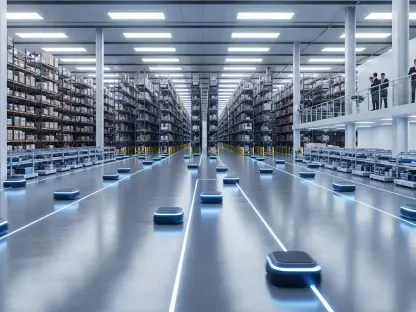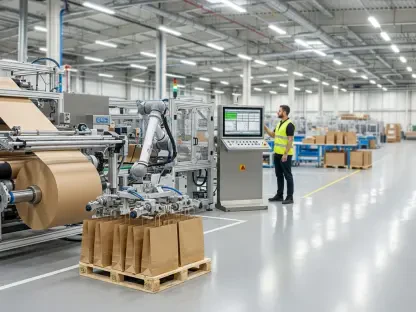Amid an evolving threat landscape facing Industrial Control System (ICS) computers, there has been a considerable uptick in ransomware attacks despite a minor overall decline in other cyber threats. Recent analysis highlights that 23.5% of ICS computers globally were exposed to cyber threats in the second quarter of 2024, a slight decrease of 0.9 percentage points from the first quarter. However, the rise in ransomware attacks is alarming, demonstrating a 20% increase over the previous quarter. Alongside ransomware, spyware continues to be a significant threat, with the percentage of ICS computers affected by spyware escalating from 3.90% to 4.08%.
Escalating Ransomware and Persistent Spyware Threats
The Alarming Increase in Ransomware Attacks
The surge in ransomware attacks represents a dramatic shift in the cyber threat landscape for ICS computers. Unlike other malicious activities that have seen a decline, ransomware showed a 20% spike from the previous quarter. This increase is particularly concerning for industries heavily reliant on continuous and uninterrupted operations such as manufacturing, energy, and transportation. The critical nature of these sectors makes them ideal targets for ransomware attackers aiming for maximum disruption and high ransom payouts.
Ransomware attacks often disable systems by encrypting crucial data, thereby halting production lines, interrupting energy supplies, and grounding transportation networks. This disruptive potential places immense pressure on organizations to pay ransoms to restore normalcy swiftly. The urgency inherent in these situations can lead to hasty and costly decisions, which further incentivizes ransomware operators. Consequently, the importance of preemptive security measures and rapid response plans cannot be overstated in mitigating these risks.
Persistent Threats from Spyware
Spyware remains a critical concern within the ICS security landscape. Despite being overshadowed by the recent ransomware surge, spyware has shown a consistent and worrying presence, increasing from 3.90% to 4.08% in the affected ICS computers. Spyware’s primary objective is to stealthily infiltrate systems and extract sensitive information without detection, which can later be sold on the dark web or used for more sophisticated attacks.
These stolen credentials, especially those for corporate accounts, pose significant long-term risks. Detailed and well-executed spyware campaigns can lead to comprehensive data breaches, resulting in unauthorized access to sensitive corporate information and critical business operations. The impact of spyware, while not immediately disruptive, builds over time, compromising system integrity and exposing organizations to potential future attacks that could be even more devastating.
Advanced Attack Techniques and Sector Vulnerabilities
The Sophistication of Attack Techniques
Advanced attackers are constantly refining their methods, making detection and defense increasingly challenging. One prevalent technique involves fileless execution, often used to install cryptocurrency malware. This method allows attackers to run malicious code directly in memory without leaving any footprint on the hard drive, thereby evading traditional signature-based antivirus programs that rely on detectable file artifacts. Fileless malware is especially problematic for ICS environments, which typically run legacy systems not designed with modern security threats in mind.
The silent and stealthy nature of fileless malware ensures it can operate undetected for prolonged periods, during which it can siphon off valuable computation resources for cryptocurrency mining or other malicious uses. The financial incentives of such attacks, coupled with the reduced risk of detection, make this method particularly attractive to cybercriminals. Integrating advanced threat detection tools capable of identifying abnormal in-memory activities is critical to defending against these sophisticated methods.
The Most Targeted Sectors: Building Automation
The building automation sector has emerged as the most targeted by cyber attackers. This sector controls and automates a variety of systems, including HVAC, lighting, security, and other critical infrastructure. The vulnerabilities within building automation networks are often exploited due to outdated protocols, insufficient patches, and a general lack of standard controls. Despite an overall decline in attacks across all sectors, these inherent weaknesses continue to make building automation systems prime targets for cyber threats.
As building automation systems are integrally connected to the operational integrity and safety of physical environments, any compromise can have far-reaching consequences. For instance, a successful breach can lead to unauthorized access to security systems, manipulation of environmental controls, and even the triggering of fail-safe mechanisms that disrupt normal building operations. Given these stakes, prioritizing investment in robust cybersecurity measures tailored explicitly for building automation systems is essential for minimizing vulnerabilities and mitigating potential attacks.
Strengthening Cybersecurity Measures for ICS
Comprehensive Security Solutions
To combat the increasing threats, implementing stringent cybersecurity measures is crucial. Regular security analysis of Operational Technology (OT) systems and continuous vulnerability assessments form the foundation of a robust defensive posture. Timely updates and patches for OT network components are necessary to close security gaps that could be exploited by attackers. Deploying specialized solutions like Kaspersky Industrial CyberSecurity can enhance protection through sophisticated threat detection capabilities tailored specifically for industrial environments.
Utilizing ICS Threat Intelligence Reporting can offer crucial insights into emerging malicious campaigns and vulnerabilities, helping organizations stay ahead of potential threats. Extended Detection and Response (XDR) solutions, such as Kaspersky Next XDR Expert, are particularly effective in identifying and mitigating early-stage threats. These solutions integrate data from multiple sources across the IT and OT environments to provide a unified and comprehensive defense strategy that enhances visibility and response capabilities.
Essential Security Training
In the context of a shifting threat landscape targeting Industrial Control System (ICS) computers, there has been a noticeable increase in ransomware attacks even though there is a slight overall decline in other cyber threats. Recent studies indicate that 23.5% of ICS computers globally faced cyber threats in the second quarter of 2024. This is a small decline of 0.9 percentage points from the first quarter. However, the surge in ransomware attacks is particularly concerning, marking a 20% rise compared to the previous quarter. Besides ransomware, spyware remains a considerable threat to ICS computers, with the percentage of systems affected by spyware rising from 3.90% to 4.08%. This trend emphasizes the urgent need for stronger cybersecurity measures to protect these critical systems. Ensuring robust defenses becomes even more crucial as industrial systems play a pivotal role in the infrastructure and security of modern society.









